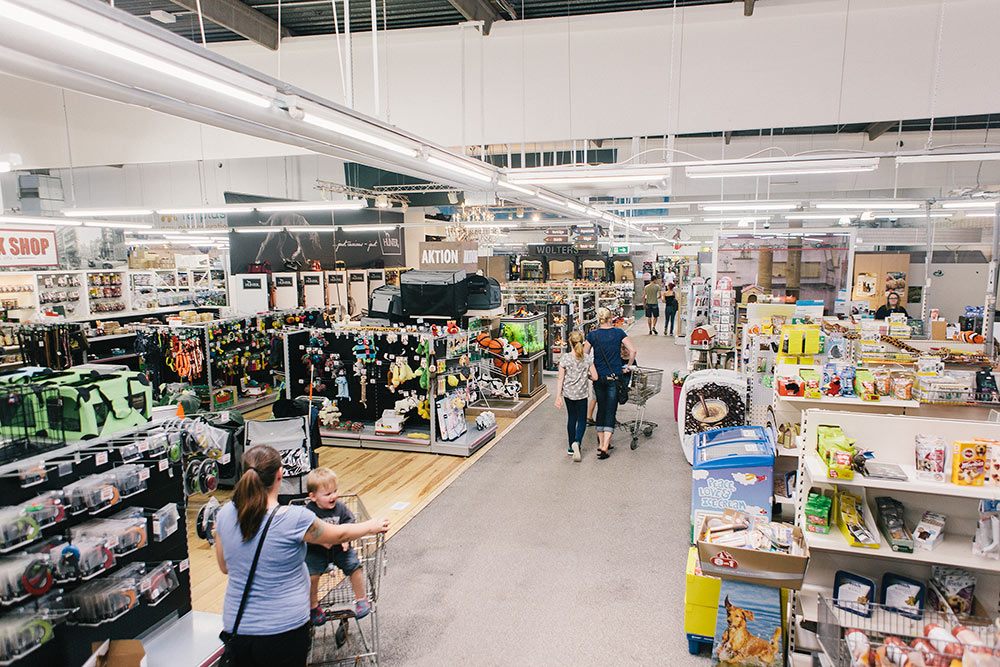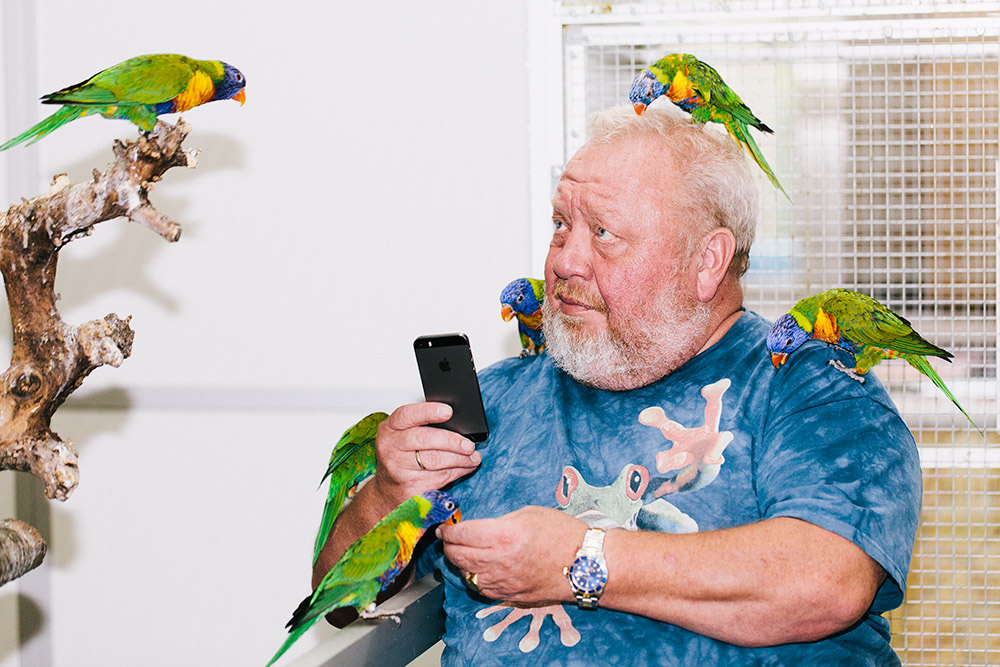The world's biggest pet store
Germany's Zoo Zajac has 250,000 animals in stock, from armadillos to meerkats to sloths

Norbert Zajac got his first pet, a golden hamster, when he was 4 years old. He took good care of her and bought a second hamster one year later. By the time he was 8, Zajac had bred more than 100 golden hamsters in the basement of his family's little home. His parents, a highway cop and a housewife in Gladbeck, Germany, said he could keep as many pets as he wanted, as long as he paid for them himself.
Zajac began selling hamsters to local pet shops. He diversified, adding guinea pigs, salamanders, tortoises, and a crocodile. He took over the family garden and started raising birds. "When I found out about an animal, I wanted to hold it, and when I held an animal, I wanted to breed it," Zajac says. When he was in fifth grade, schools began taking field trips to his house. He became Germany's youngest licensed parrot breeder in 1967, when he was 13, and quickly cornered the local market on parakeets by training them to breed at Christmastime. At 14, Zajac asked a career counselor what he should do with his life. He was told to become a steelworker.
It was easy advice to give in the 1970s to a young man from the Ruhr Valley, the heart of the West German steel industry and the most populated part of the country. Zajac, who never graduated from high school, worked early shifts at the steel mill so he could be home to tend his animals before dusk. At 18, he sold most of his pets after he was conscripted into the military. Two years later, he was working again at the mill when he saw an advertisement in the local paper. A pregnant woman in the city of Duisburg, near the Dutch border, was trying to sell her pet shop before she gave birth. Zajac borrowed money from his father and took over the small store on a quiet residential street in 1975.
The Week
Escape your echo chamber. Get the facts behind the news, plus analysis from multiple perspectives.

Sign up for The Week's Free Newsletters
From our morning news briefing to a weekly Good News Newsletter, get the best of The Week delivered directly to your inbox.
From our morning news briefing to a weekly Good News Newsletter, get the best of The Week delivered directly to your inbox.
Today, Zajac's pet shop fills a 130,000-square-foot warehouse in an industrial part of Duisburg. It's called Zoo Zajac, and it unfurls, like an airport terminal, along a horseshoe in the road. It's more than twice the size of the White House, and is, according to Guinness World Records, the biggest pet shop in the world. A visitor can spend as much as 9,000 euros ($10,000) on a two-toed sloth or as little as 1.19 euros ($1.34) on a box of crickets. She can buy armadillos, meerkats, coatis, and monkeys; or fill aquariums with jellyfish, tetras, shellfish, and piranhas. Zoo Zajac sells 50 species of tarantula and maintains one of the finest reptile collections in Western Europe — better, even, than many zoos'. It houses about 250,000 individual animals of 3,000 different species. A walk around the place is essentially an endurance sport, which is why Zajac, a heavy man with two bad knees, zips up and down the aisles on a black moped. The vehicle never leaves the premises and logs more than 2,500 miles a year.

Zoo Zajac has become for the Ruhr Valley what Zajac's childhood home was for his classmates. "It's almost used as a gratis zoo by the people," says Ulrich Schürer, the former director of the nearby Zoo Wuppertal. As many as 12,000 visitors will arrive on a Saturday, and many of them won't buy anything at all, except for perhaps a currywurst or coffee at the cafeteria. Even the proper customers rarely obtain animals; the majority purchase only the tens of thousands of pet-care products that line the shelves between Zoo Zajac's tanks and cages: everything from aquarium filters to dog leashes to eyedrops for turtles. Live animals are expensive to maintain in a pet shop, and demand is relatively small. In the U.S., they make up only 6 percent of the retail pet market. "A pet store mostly subsists off of accessories and merchandise associated with the animal," Zajac says. "If I sold only animals, I would lose 250,000 euros a year."
This has given rise to what he calls, sneeringly, die Tierhandlung ohne Tiere, or "the pet shop without pets." Many of the most successful pet businesses have stopped selling animals or scaled back to just a few low-maintenance species, even though their customers are crazier than ever about their little friends. In Western countries, where family sizes are shrinking, pet owners no longer treat their animals as property, but as children, pampering them with products and services that would have once seemed ridiculous: bottled water, gluten-free kibble, doggy diapers, designer beds. The "humanization" trend has benefited more than just animals. The U.S. pet industry has more than tripled, to $60 billion, over the past 20 years, and pet care was one of the few retail industries to grow during the Great Recession.
Much of that growth, though, has accrued to big-box retailers rather than small pet shops. Chains slashed operating costs by eliminating live animals, and exploited economies of scale to sell an ever-increasing variety of products as cheaply as possible. In the U.S., PetSmart and Petco Animal Supplies capture more than half of industry revenue. In Germany, the pet-care chain Fressnapf operates more than 800 locations and claims nearly a third of all sales. Germany still has more than 5,000 independent pet shops, but their market share has dwindled to less than 15 percent.
A free daily email with the biggest news stories of the day – and the best features from TheWeek.com
"See the Bible, David and Goliath," says Zajac. "I am the little one with the slingshot." It's not the identification you would expect from the owner of the biggest pet shop in the world, but bigness was, for Zajac, an adaptation. While many independent shops disappeared or turned to high-end services like grooming or day care, Zajac took the opposite tack. He survived not through specialization, but through spectacle — by building a pet shop so large that it has gravitational pull.
Zajac's personal tour of Zoo Zajac can last as long as five hours and never takes less than two. Highlights include Zajac feeding grasshoppers to a family of little monkeys, who bite off the heads and gobble up the bodies two-handed, like a hoagie, and a call-and-response duet between peacocks and the horn on Zajac's moped. Zajac might also feed fresh eggs from his chickens to a monitor lizard, or tell you to look up when you pass underneath the sloths, who hang from ropes on the ceiling. He'll warn you not to pet the ferrets: Last year he called five ambulances for ferret bites alone.
After he's led you through the exotic mammals, the terrarium, the garden, the aquarium, the puppies, the birds, and the small mammals, he might take you to the parking lot for one of his favorite shows of all. On a recent Saturday morning, Zajac rested his hand on the trunk of a customer's car and leaned over to examine the license plate. "Cologne," he said. "A hundred kilometers." Zajac had left his moped inside, so he shuffled to the next car and inspected its license plate as well. "Wuppertal," he said. "Eighty kilometers." He continued down the row of tiny European vehicles, estimating the distance of their journey to his store. Zajac was disappointed to find only a couple of international visitors, from the Netherlands; often he finds plates from hundreds of miles away, from France, Poland, and the U.K.
Germany isn't the country where most people would expect to find the world's biggest pet shop. Most German businesses are modest enterprises, and consumers there aren't impressed by immensity in and of itself. But German pet ownership gets a little weird. In the U.S. the humanization trend has ridden largely on the backs of dogs and cats, whose owners spend the most money on their pets but are the least likely to buy their animals in pet shops. Germany, however, has some of the lowest rates of dog and cat ownership in all of Europe. Instead, there's an abundance of so-called exotic pets. Germans keep more small mammals — everything from chinchillas to ferrets to rabbits — per capita than all other Europeans, save the Dutch, and the country also has large populations of pet reptiles and fish.
Partly this is because of a "dog tax" that Germany imposes on owners of man's best friend, but there are other reasons for the popularity of rodents and reptiles. These animals suit Germans' famously fastidious lifestyles. "Small animals make less mess," Zajac says, "and they do not bother the neighbors." Germans are also, by reputation, more analytical than sentimental, which could help explain their interest in animals that are observed in tanks or cages rather than commingled in the family home. Seven of the 10 most visited European zoos in 2013 were in Germany, and the remaining three were in German-speaking Austria and Switzerland. (Zoo Zajac, which has about 1 million visitors annually, would rank in the top 30 of European zoos if it were eligible.)
Zoo Zajac's growth was fueled by Germany's development into the European country with the most money and the lowest birth-rate, the two factors that lead consumers to lavish money on their pets. Residents of North Rhine–Westphalia, the state that contains Duisburg, spend more on their pets than any other Germans. Zajac used to laugh about customers who spoiled their pets like children, but by 2000 their behavior was the norm. "Before, if somebody had a pond in their backyard, they would buy a bunch of goldfish at Easter and plant a bunch of flowers around the pond," he says. "One week after Easter, the plants would be dead and the goldfish would be dead, too. Now if you buy a goldfish and it gets sick, you take it to the veterinarian."
Zoo Zajac opened in its current location on Nov. 17, 2004. A few months later, Guinness World Records paid a visit. Zoo Zajac was, at the time, two-thirds of its present size, still large enough to earn it the distinction of the biggest pet shop in the world. Zajac lives on the second floor in a modest apartment behind his office with his wife, Jutta, and a mother-daughter pair of dachshunds. "I had to help the mother give birth here on the living room table," he says. When Zajac is watching TV or relaxing in his hot tub, he's never more than a flight of stairs away from his animal collection, just like when he bred hamsters in his basement as a little boy.
In 2012, Zajac added a controversial mammal to his inventory. Animal rights activists picketed the store and called him greedy and irresponsible. More than 25,000 people sent a protest letter from PETA that included a cartoon of Zajac strangling the creature with a price tag around its neck. Zajac says he received multiple bomb and death threats. One pet food manufacturer withdrew its products from the store's shelves. Even the German Pet Trade & Industry Association didn't support him. Zoo Zajac had started selling puppies.
Zajac always sold dog food and supplies, but like all German pet shop owners, he'd stopped selling dogs themselves in the 1970s. He quit cats in 1985. People increasingly disapproved of the sale of the most affectionate species, and, despite Zoo Zajac's continual growth, it was hard to find sufficient space for cats and dogs in the store. Germany never legally prohibited their sale, but no other German pet shop was selling dogs when Zoo Zajac resumed in 2012. Zajac spent 800,000 euros on large kennels with heated floors and outdoor sections.
Today, Zoo Zajac is still the only pet store in Germany where you can buy a dog.
The biggest question facing Zoo Zajac today may be whether it can outlive the man who built it. Zajac is just 60 years old, but he's not a paragon of health. He claims to have already died and been resuscitated on the operating table four times. The first three deaths came after he was stung by lionfish at Zoo Zajac, and the fourth happened during knee replacement surgery. He's entrusted 49 percent of the company to his eldest daughter, Katja Banaszak, who will run it when he's no longer able. "He always has extreme ideas," she says, with loving exasperation. "He wants to have penguins." Zajac thinks he can get them from a German zoo, but so far his daughter has persuaded him to hold off. Banaszak doesn't think the world's biggest pet shop needs penguins, or any other new animals. "It's big enough already."
Excerpted from an article that originally appeared in Bloomberg.com. Reprinted with permission.
-
 A luxury walking tour in Western Australia
A luxury walking tour in Western AustraliaThe Week Recommends Walk through an ‘ancient forest’ and listen to the ‘gentle hushing’ of the upper canopy
-
 What Nick Fuentes and the Groypers want
What Nick Fuentes and the Groypers wantThe Explainer White supremacism has a new face in the US: a clean-cut 27-year-old with a vast social media following
-
 5 highly amusing cartoons about rising health insurance premiums
5 highly amusing cartoons about rising health insurance premiumsCartoon Artists take on the ACA, Christmas road hazards, and more